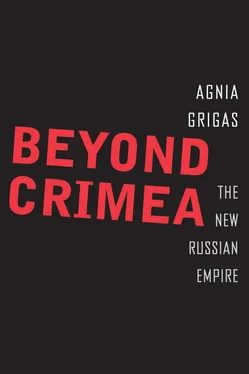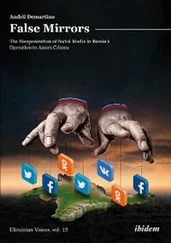Despite some initial delay, Stankevich’s policy document did not go unnoticed. In February 1994, Yeltsin officially declared to the Federal Assembly the necessity of formulating a policy toward compatriots abroad. He also determined the future conceptualization and discourse regarding Russia’s compatriots: Russia should help its compatriots not with coming back to the “historically native land,” but with settling down in foreign states. In his speech, Yeltsin issued a call that “everywhere, where our compatriots live, they should feel themselves full and equal citizens,” and defined a range of tasks of foreign policy aimed to support the “interests of Russians in the CIS countries and the Baltic states.” 47Although at the time these measures were probably mostly intended to assist Russians in settling into their countries of residence, the seeds of Russian compatriot policy as a means of influence in the former Soviet republics were planted for future use by Putin’s regime. Since then, Russian politicians have maintained the notion of a certain duty to defend the rights of Russians and Russian speakers against the ethnic elites of the former Soviet republics as they pursued in Moscow’s eyes a “decolonizing” process. 48
The mechanisms to support Russian compatriots, however, were lacking, until in August 1994 the government passed a resolution approving two documents: “Guidelines on State Policy regarding Compatriots Living Abroad” and “List of Primary Measures to Support Compatriots Abroad.” The government also established a Governmental Commission on Affairs of Compatriots Abroad composed of government, presidential office, and social organization officials and representatives of other groups. 49Regardless of the failure to clearly define “compatriots,” the documents maintained that state policy would be implemented toward two categories of people: emigrants from Russia and the USSR (including their descendants) and the Russian-speaking population of the former Soviet Union republics. 50Two different policies were proposed regarding these two categories of compatriots. Emigrants to the West were to be encouraged to regain Russian citizenship and return to the “historically native land” of Russia. Probably few emigrants to the United States and Europe were actually expected to return to Russia. In contrast, for Russian speakers in the near abroad, the policy focused on “prevention of mass migration” from the former Union Republics to Russia. Sociologist Hilary Pilkington aptly noted that at the time the Russian government was in favor of preventing “compatriots” becoming “repatriates.” 51This policy of limiting repatriation was named as one of the main factors in changing the migration dynamics of the Russian population from Central Asia, which had rapidly decreased but at a slower rate after the limits were imposed in 1994. In that year 234,000 Russians migrated from Kazakhstan to Russia, but in 1995 this number fell to 144,000; 93,500 Russians left Uzbekistan in 1994, but in 1995 only 64,200; 42,900 left Kyrgyzstan in 1994, and 13,400 in 1995. 52Still, most Russians who wanted to repatriate had already done so in the early 1990s.
Certainly, it appears ironic that Moscow seemed to want to claim this population, but not necessarily bring it back to the motherland. While it is impossible to ascribe this policy to a single motive, several reasons are possible. First, as Russia’s own domestic population was experiencing severe economic hardships following the fall of the USSR, Moscow could not have provided for another 25 million returnees. Russia’s housing, pension, education, and health care systems were already under strain. Secondly, unemployment and underemployment were rampant in Russia in the 1990s so there were simply not enough jobs for repatriates. Thirdly, it is likely that the Kremlin already saw the strategic potential of its compatriots as long as they remained in the near abroad. As will be discussed later, some of the Kremlin’s advisers like Sergey Karaganov were highlighting the role that compatriots could play in foreign policy. During the Soviet era, the Russian minorities had served administrative, bureaucratic, intelligence, and military roles in the Soviet republics and later they often gained prominence in the economic and to a lesser extent political systems of the independent post-Soviet states, thus serving as a useful interest group for Moscow. 53Many factors probably influenced Russia’s decision to promote the integration of the diaspora into the newly independent post-Soviet states while at the same time seeking to protect it.
First, however, Moscow had to define the term “compatriot.” The first official definition appeared in the end of 1995 when the State Duma adopted the “Declaration on Support of the Russian Diaspora and Protection of Russian Compatriots.” 54The document defined Russian compatriots as “all the natives of the USSR and Russia and all their descendants regardless of their nationality and ethnicity, language, religion, gender, occupation and place of residence and other circumstances, who are not citizens of the Russian Federation but explicitly declare their spiritual, cultural, and ethnic ties with the Russian Federation or with any districts of Russian Federation and confirm this relationship.” 55However, the declaration did not specify or prescribe how this spiritual, cultural, and ethnic affiliation should be demonstrated. 56Clearly, this definition was exceedingly broad. As a result, at the end of 1995, almost anyone who was not a Russian citizen but had any connection with Russia or the USSR could have been deemed a Russian compatriot. Also, any former citizen of Russia or the USSR and his or her direct descendants could be classified as a “compatriot” if they expressed this preference. While the declaration and its definition had little practical effect on the Russian compatriots, it signaled that Russia sought to define them in a broader rather than a narrower sense of the word.
As it was immediately evident that the breadth of this definition would make it difficult to enact policies, the Russian government’s “Action Program for Protecting Compatriots Abroad” of May 1996 called for “a legal definition of the concept ‘compatriot’ and its further use in the legislation.” 57The new policy document maintained the position of 1994 limiting repatriation and argued that Russian compatriots “had to live and determine their own destiny in complex political, economic, social, cultural, [and] psychological conditions and they need assistance and support both from the states where they reside and from Russia.” 58The Russian state once again opted for the integration of compatriots into their countries of residence rather than repatriate. The role of the Russian government was reasonably envisioned as rather limited: “Russia as the successor of the USSR has a moral responsibility to compatriots” and should assist other states in safeguarding their rights. 59The document of 1996 also pointed out that “the issue of compatriots is a significant factor in the formation of relations between Russia and the members of the CIS and the Baltic States.” 60Already in June 1995, while visiting Kaliningrad Yeltsin stated that “guaranteeing the basic rights and freedoms of our compatriots [in the Baltics] is a priority for me” and that “abuse of Russians’ civil rights in Latvia and Estonia was hindering attempts by Moscow to improve ties with the Baltic states.” 61Russian minorities in Estonia and Latvia did arguably face some legitimate discomfort over the need to undergo the naturalization process as well as uncertainty over their future legal residential status, but the exaggerated rhetoric of “basic rights and freedoms,” in light of the fact that the Russian government did not welcome the repatriation of compatriots and had not legally defined them, brings into question the sincerity of Yeltsin’s concern.
Читать дальше












